
Orthopedic Surgery
Whether you have just begun exploring treatment options or have already decided with your orthopaedic surgeon to have total knee replacement surgery, this article will help you understand more about this valuable procedure.
Anatomy
The knee is the largest joint in the body. Normal knee function is required to perform most everyday activities. The knee is made up of the lower end of the thighbone (femur), which rotates on the upper end of the shin bone (tibia), and the kneecap (patella), which slides in a groove on the end of the femur. Large ligaments attach to the femur and tibia to provide stability. The long thigh muscles give the knee strength.
Fig : Normal knee anatomy.
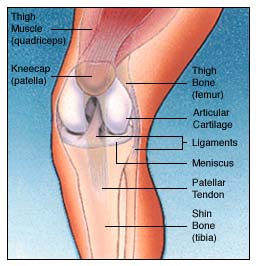 The joint surfaces where these three bones touch are covered with articular cartilage, a smooth substance that cushions the bones and enables them to move easily.
The joint surfaces where these three bones touch are covered with articular cartilage, a smooth substance that cushions the bones and enables them to move easily.
All remaining surfaces of the knee are covered by a thin, smooth tissue liner called the synovial membrane. This membrane releases a special fluid that lubricates the knee, reducing friction to nearly zero in a healthy knee.
Normally, all of these components work in harmony. But disease or injury can disrupt this harmony, resulting in pain, muscle weakness, and reduced function.
Common Causes of Knee Pain and Loss of Knee Function
Fig : Knee with arthritis.
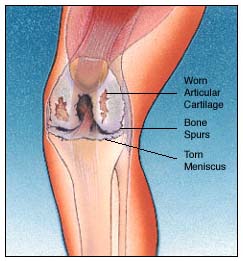 The most common cause of chronic knee pain and disability is arthritis. Osteoarthritis, rheumatoid arthritis, and traumatic arthritis are the most common forms.
The most common cause of chronic knee pain and disability is arthritis. Osteoarthritis, rheumatoid arthritis, and traumatic arthritis are the most common forms.
- Osteoarthritis usually occurs in people 50 years of age and older and often in individuals with a family history of arthritis. The cartilage that cushions the bones of the knee softens and wears away. The bones then rub against one another, causing knee pain and stiffness.
- Rheumatoid arthritis is a disease in which the synovial membrane becomes thickened and inflamed, producing too much synovial fluid that overfills the joint space. This chronic inflammation can damage the cartilage and eventually cause cartilage loss, pain, and stiffness.
- Traumatic arthritis can follow a serious knee injury. A knee fracture or severe tears of the knee ligaments may damage the articular cartilage over time, causing knee pain and limiting knee function.
Is Total Knee Replacement for You?
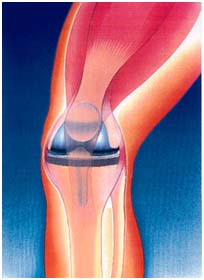
Whether to have total knee replacement surgery should be a cooperative decision made by you, your family, your family physician, and your orthopaedic surgeon. Your physician may refer you to an orthopaedic surgeon for a thorough evaluation to determine if you could benefit from this surgery. Alternatives to traditional total knee replacement surgery that your orthopaedic surgeon may discuss with you include a unicompartmental knee replacement or a minimally invasive knee replacement.
Reasons that you may benefit from total knee replacement commonly include :
- Severe knee pain that limits your everyday activities, including walking, climbing stairs, and getting in and out of chairs. You may find it hard to walk more than a few blocks without significant pain and you may need to use a cane or walker.
- Moderate or severe knee pain while resting, either day or night
- Chronic knee inflammation and swelling that does not improve with rest or medications
- Knee deformity: a bowing in or out of your knee
- Knee stiffness: inability to bend and straighten your knee
- Failure to obtain pain relief from nonsteroidal anti-inflammatory drugs. These medications, including aspirin and ibuprofen, often are most effective in the early stages of arthritis. Their effectiveness in controlling knee pain varies greatly from person to person. These drugs may become less effective for patients with severe arthritis.
- Inability to tolerate or complications from pain medications
- Failure to substantially improve with other treatments such as cortisone injections, physical therapy, or other surgeries
Most patients who undergo total knee replacement are age 60 to 80, but orthopaedic surgeons evaluate patients individually. Recommendations for surgery are based on a patient's pain and disability, not age. Total knee replacements have been performed successfully at all ages, from the young teenager with juvenile arthritis to the elderly patient with degenerative arthritis.
The Orthopaedic Evaluation
The orthopaedic evaluation consists of several components :
- A medical history, in which your orthopaedic surgeon gathers information about your general health and asks you about the extent of your knee pain and your ability to function
- A physical examination to assess knee motion, stability, strength, and overall leg alignment
- X-rays (radiographs) to determine the extent of damage and deformity in your knee
- Occasionally blood tests, MRI (magnetic resonance imaging), or bone scanning may be needed to determine the condition of the bone and soft tissues of your knee.
 Your orthopaedic surgeon will review the results of your evaluation with you and discuss whether total knee replacement would be the best method to relieve your pain and improve your function. Other treatment options-including medications, injections, physical therapy, or other types of surgery-also will be discussed and considered.
Your orthopaedic surgeon will review the results of your evaluation with you and discuss whether total knee replacement would be the best method to relieve your pain and improve your function. Other treatment options-including medications, injections, physical therapy, or other types of surgery-also will be discussed and considered.
Your orthopaedic surgeon also will explain the potential risks and complications of total knee replacement, including those related to the surgery itself and those that can occur over time after your surgery.
Realistic Expectations About Knee Replacement Surgery
An important factor in deciding whether to have total knee replacement surgery is understanding what the procedure can and cannot do.
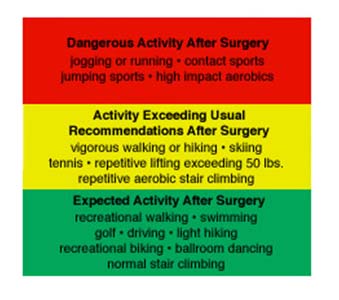 More than 90% of individuals who undergo total knee replacement experience a dramatic reduction of knee pain and a significant improvement in the ability to perform common activities of daily living. But total knee replacement will not make you a super-athlete or allow you to do more than you could before you developed arthritis.
More than 90% of individuals who undergo total knee replacement experience a dramatic reduction of knee pain and a significant improvement in the ability to perform common activities of daily living. But total knee replacement will not make you a super-athlete or allow you to do more than you could before you developed arthritis.
Following surgery, you will be advised to avoid some types of activity, including jogging and high-impact sports, for the rest of your life.
With normal use and activity, every knee replacement develops some wear in its plastic cushion. Excessive activity or weight may accelerate this normal wear and cause the knee replacement to loosen and become painful. With appropriate activity modification, knee replacements can last for many years.
Preparing for Surgery
 If you decide to have total knee replacement surgery, you may be asked to have a complete physical examination by your family physician several weeks before surgery to assess your health and to identify any conditions that could interfere with your surgery.
If you decide to have total knee replacement surgery, you may be asked to have a complete physical examination by your family physician several weeks before surgery to assess your health and to identify any conditions that could interfere with your surgery.
Tests
Several tests may be needed to help plan your surgery: blood and urine samples may be tested and a cardiogram may be obtained.
Preparing Your Skin and Leg
Your knee and leg should not have any skin infections or irritation. Your lower leg should not have any chronic swelling. Contact your orthopaedic surgeon prior to surgery if either of these conditions is present for a program to best prepare your skin for surgery.
Blood Donation
You may be advised to donate your own blood prior to the surgery. It will be stored in the event you need blood after your surgery.
Medications
Tell your orthopaedic surgeon about the medications you are taking. He or she will tell you which medications you should stop taking and which you should continue to take before surgery.
Dental Evaluation
Although the incidence of infection after knee replacement is very low, an infection can occur if bacteria enter your bloodstream. Treatment of significant dental diseases (including tooth extractions and periodontal work) should be considered before your total knee replacement surgery.
Urinary Evaluations
A preoperative urological evaluation should be considered for individuals with a history of recent or frequent urinary infections. For older men with prostate disease, required treatment should be considered prior to knee replacement surgery.
Social Planning
Although you will be able to walk on crutches or a walker soon after surgery, you will need help for several weeks with such tasks as cooking, shopping, bathing, and doing laundry. If you live alone, your orthopaedic surgeon's office and a social worker, or a discharge planner at the hospital can help you make advance arrangements to have someone assist you at home. They also can help you arrange for a short stay in an extended-care facility during your recovery, if this option works best for you.
Home Planning
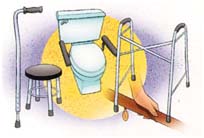 The following is a list of modifications that can make your home easier to navigate during your recovery :
The following is a list of modifications that can make your home easier to navigate during your recovery :
- Safety bars or a secure handrail in your shower or bath
- Secure handrails along your stairways
- A stable chair for your early recovery with a firm seat cushion (and a height of 18 to 20 inches), a firm back, two arms, and a footstool for intermittent leg elevation
- A toilet seat riser with arms, if you have a low toilet
- A stable shower bench or chair for bathing
- Removing all loose carpets and cords
- A temporary living space on the same floor because walking up or down stairs will be more difficult during your early recovery
Your Total Knee Replacement Surgery in India
You will most likely be admitted to the hospital on the day of your surgery. After admission, you will be evaluated by a member of the anesthesia team. The most common types of anesthesia are general anesthesia, in which you are asleep throughout the procedure, and spinal or epidural anesthesia, in which you are awake but your legs are anesthetized. The anesthesia team will determine which type of anesthesia will be best for you with your input.
The procedure itself takes approximately 2 hours. Your orthopaedic surgeon will remove the damaged cartilage and bone and then position the new metal and plastic joint surfaces to restore the alignment and function of your knee.
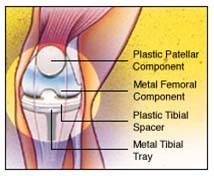 Many different types of designs and materials are currently used in total knee replacement surgery, nearly all of which consist of three components: the femoral component (made of a highly polished strong metal), the tibial component (made of a durable plastic often held in a metal tray), and the patellar component (also plastic).
Many different types of designs and materials are currently used in total knee replacement surgery, nearly all of which consist of three components: the femoral component (made of a highly polished strong metal), the tibial component (made of a durable plastic often held in a metal tray), and the patellar component (also plastic).
After surgery, you will be moved to the recovery room, where you will remain for 1 to 2 hours while your recovery from anesthesia is monitored. After you awaken, you will be taken to your hospital room.
Unicompartmental Knee Replacement
Although not as common as total knee replacement, the partial or unicompartmental knee replacement (commonly called the "uni") is a viable alternative in limited situations. The designs of the unicompartmental types of knee replacements have improved over the years, as has the sophistication of the instruments used to implant these types of artificial joints. The unicompartmental knee replacement also has smaller, less invasive incisions.
The unicompartmental knee replacement is used to replace a single compartment of the arthritic knee. The knee joint has three compartments: the medial (inner) compartment, the lateral (outer) compartment, and the patellofemoral (kneecap) compartment. If the damage is limited to either the medial or lateral compartment, that compartment may be replaced with the unicompartmental knee implant.
If two or more compartments are damaged, unicompartmental knee replacement may not be the best option. Unicompartmental knee replacement is also less desirable for a young, active person because it may not withstand the extremes of stress that high levels of activity create. It is best suited for the older, slim person with a relatively sedentary lifestyle. Only between 6 and 8 out of 100 patients with arthritic knees are good candidates for unicompartmental knee replacement.
Because the unicompartmental knee replacement can be inserted through a relatively small incision (approximately 3 to 4 inches long), which does not interrupt the main muscle controlling the knee, rehabilitation is faster, hospitalization is shorter, and return to normal activities is more rapid than after a total knee replacement.
However, this is still a serious surgical procedure, and has all of the same risks as total knee replacement. These risks, as well as whether you are a good candidate for unicompartmental knee replacement, should be discussed with your orthopaedic surgeon.
Minimally Invasive Knee Replacement
A recent advance in the performance of total knee replacement is the use of minimally invasive surgical approaches. This technique, still in its relative infancy, is more challenging than standard total knee replacement. The incisions are approximately half the size of those used in a standard approach. The smaller incisions and new techniques to expose the joint may result in short-term advantages such as a quicker rehabilitation, less pain, and a shorter hospitalization, according to some reports.
The minimally invasive approach to the total knee replacement is appropriate for non-obese patients who have reasonable motion without significant deformity. Hospitalization may be reduced to 1 to 3 days among these patients, and the need for an extended stay for inpatient rehabilitation may be reduced or eliminated in most patients.
Although some studies show shorter hospitalizations and rehabilitation periods, other studies find minimally invasive surgical techniques to be no better than standard techniques. Although the risks are not well known, they are probably comparable to those for a standard total knee replacement. Speak to your orthopaedic surgeon about whether you are an appropriate candidate for this particular approach to total knee replacement.
Your Stay in the Hospital
You will most likely stay in the hospital for several days. After surgery, you will feel some pain, but medication will be given to you to make you feel as comfortable as possible. Because pain management is an important part of your recovery, talk with your surgeon if postoperative pain becomes a problem. Walking and knee movement are important to your recovery and will begin immediately after your surgery.
To avoid lung congestion after surgery, you should breathe deeply and cough frequently to clear your lungs.
Your orthopaedic surgeon may prescribe one or more measures to prevent blood clots and decrease leg swelling, such as special support hose, inflatable leg coverings (compression boots), and blood thinners.
To restore movement in your knee and leg, your surgeon may use a knee support that slowly moves your knee while you are in bed. The device, called a continuous passive motion (CPM) exercise machine, decreases leg swelling by elevating your leg and improves your venous circulation by moving the muscles of your leg.
Foot and ankle movement also is encouraged immediately following surgery to increase blood flow in your leg muscles to help prevent leg swelling and blood clots. Most patients begin exercising their knee the day after surgery. A physical therapist will teach you specific exercises to strengthen your leg and restore knee movement to allow walking and other normal daily activities soon after your surgery.
Complications
The complication rate following total knee replacement is low. Serious complications, such as a knee joint infection, occur in fewer than 2% of patients. Major medical complications such as heart attack or stroke occur even less frequently. Chronic illnesses may increase the potential for complications. Although uncommon, when these complications occur, they can prolong or limit full recovery.
Blood clots in the leg veins are the most common complication of knee replacement surgery. Your orthopaedic surgeon will outline a prevention program, which may include periodic elevation of your legs, lower leg exercises to increase circulation, support stockings, and medication to thin your blood.
Although implant designs and materials as well as surgical techniques have been optimized, wear of the bearing surfaces or loosening of the components may occur. Additionally, although an average of 115° of motion is generally anticipated after surgery, scarring of the knee can occasionally occur, and motion may be more limited, particularly in patients with limited motion before surgery. Finally, although rare, injury to the nerves or blood vessels around the knee can occur during surgery.
Discuss your concerns thoroughly with your orthopaedic surgeon prior to surgery.
Your Recovery at Home
Current ten-year survival rates for fixed and mobile bearing unicompartmental knee replacements range from 90% - 95%. The success of your surgery also will depend on how well you follow your orthopaedic surgeon's instructions at home during the first few weeks after surgery.
Wound Care
You will have stitches or staples running along your wound or a suture beneath your skin on the front of your knee. The stitches or staples will be removed several weeks after surgery. A suture beneath your skin will not require removal.
Avoid soaking the wound in water until the wound has thoroughly sealed and dried. The wound may be bandaged to prevent irritation from clothing or support stockings.
Diet
Some loss of appetite is common for several weeks after surgery. A balanced diet, often with an iron supplement, is important to promote proper tissue healing and to restore muscle strength.
Activity
Exercise is a critical component of home care, particularly during the first few weeks after surgery. You should be able to resume most normal activities of daily living within 3 to 6 weeks following surgery. Some pain with activity and at night is common for several weeks after surgery.
Your activity program should include :
- A graduated walking program to slowly increase your mobility, initially in your home and later outside
- Resuming other normal household activities, such as sitting and standing and climbing stairs
- Specific exercises several times a day to restore movement and strengthen your knee. You probably will be able to perform the exercises without help, but you may have a physical therapist help you at home or in a therapy center the first few weeks after surgery.
Driving usually begins when your knee bends sufficiently so you can enter and sit comfortably in your car and when your muscle control provides adequate reaction time for braking and acceleration. Most individuals resume driving approximately 4 to 6 weeks after surgery.
Avoiding Problems After Surgery
Blood Clot Prevention
Follow your orthopaedic surgeon's instructions carefully to minimize the potential of blood clots that can occur during the first several weeks of your recovery.
Warning Signs
Warning signs of possible blood clots in your leg include :
- Increasing pain in your calf
- Tenderness or redness above or below your knee
- • Increasing swelling in your calf, ankle, and foot
Warning signs that a blood clot has traveled to your lung include :
- Sudden increased shortness of breath
- Sudden onset of chest pain
- Localized chest pain with coughing
Notify your doctor immediately if you develop any of these signs.
Preventing Infection
The most common causes of infection following total knee replacement surgery are from bacteria that enter the bloodstream during dental procedures, urinary tract infections, or skin infections. These bacteria can lodge around your knee replacement and cause an infection.
After your knee replacement, you must take preventive antibiotics before dental or surgical procedures that could allow bacteria to enter your bloodstream.
Warning signs of a possible knee replacement infection are :
- Persistent fever (higher than 100°F orally)
- Shaking chills
- Increasing redness, tenderness, or swelling of the knee wound
- Drainage from the knee wound
- Increasing knee pain with both activity and rest
Notify your doctor immediately if you develop any of these signs.
Avoiding Falls
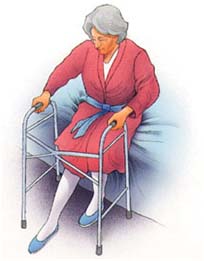 A fall during the first few weeks after surgery can damage your new knee and may result in a need for further surgery. Stairs are a particular hazard until your knee is strong and mobile. You should use a cane, crutches, a walker, or hand rails or have someone to help you until you have improved your balance, flexibility, and strength.
A fall during the first few weeks after surgery can damage your new knee and may result in a need for further surgery. Stairs are a particular hazard until your knee is strong and mobile. You should use a cane, crutches, a walker, or hand rails or have someone to help you until you have improved your balance, flexibility, and strength.
Your surgeon and physical therapist will help you decide what assistive aides will be required following surgery and when those aides can safely be discontinued.
How Your New Knee Is Different
You may feel some numbness in the skin around your incision. You also may feel some stiffness, particularly with excessive bending activities. Improvement of knee motion is a goal of total knee replacement, but restoration of full motion is uncommon. The motion of your knee replacement after surgery is predicted by the motion of your knee prior to surgery. Most patients can expect to be able to almost fully straighten the replaced knee and to bend the knee sufficiently to climb stairs and get in and out of a car. Kneeling is usually uncomfortable, but it is not harmful. Occasionally, you may feel some soft clicking of the metal and plastic with knee bending or walking. These differences often diminish with time and most patients find them to be tolerable when compared with the pain and limited function they experienced prior to surgery.
 Your new knee may activate metal detectors required for security in airports and some buildings. Tell the security agent about your knee replacement if the alarm is activated.
Your new knee may activate metal detectors required for security in airports and some buildings. Tell the security agent about your knee replacement if the alarm is activated.
After surgery, make sure you also do the following :
- Participate in regular light exercise programs to maintain proper strength and mobility of your new knee.
- Take special precautions to avoid falls and injuries. Individuals who have undergone total knee replacement surgery and experience a fracture may require more surgery.
- Notify your dentist that you had a knee replacement. You should be given antibiotics before all dental surgery for the rest of your life.
- See your orthopaedic surgeon periodically for a routine follow-up examination and x-rays (radiographs), usually once a year.
 Your orthopaedic surgeon is a medical doctor with extensive training in the diagnosis and nonsurgical and surgical treatment of the musculoskeletal system, including bones, joints, ligaments, tendons, muscles, and nerves.
Your orthopaedic surgeon is a medical doctor with extensive training in the diagnosis and nonsurgical and surgical treatment of the musculoskeletal system, including bones, joints, ligaments, tendons, muscles, and nerves.
India Surgery Total Knee Replacement, India Cost Total Knee Replacement, Total Knee Replacement Surgery, India TKR, Surgery Activities, Knee Joint Replacement, Knees, Arthritis, Artificial Knee, Cost Total Knee Replacement, Total Knee Replacement Surgery, India Knee Problems, Knee Replacement Overview, Benefits Of Total Knee Replacement, Knee Replacement Surgeon, Knee Pain, Total Knee Replacement, Total Knee Replacement Surgery Risks, Operation, Total Knee Replacement Surgery
Total Knee Replacement India offers information on Total Knee Replacement in India, Total Knee Replacement cost India, Total Knee Replacement hospital in India, Delhi, Mumbai, Chennai, Hyderabad & Bangalore, Total Knee Replacement Surgeon in India
If your knee is severely damaged by arthritis or injury, it may be hard for you to perform simple activities such as walking or climbing stairs. You may even begin to feel pain while you are sitting or lying down.
If medications, changing your activity level, and using walking supports are no longer helpful, you may want to consider total knee replacement surgery. By resurfacing the damaged and worn surfaces of the knee can relieve pain, correct leg deformity and help resume normal activities.
One of the most important orthopaedic surgical advances of the twentieth century, knee replacement was first performed in 1968. Improvements in surgical materials and techniques since then have greatly increased its effectiveness.


 The joint surfaces where these three bones touch are covered with articular cartilage, a smooth substance that cushions the bones and enables them to move easily.
The joint surfaces where these three bones touch are covered with articular cartilage, a smooth substance that cushions the bones and enables them to move easily.  The most common cause of chronic knee pain and disability is arthritis. Osteoarthritis, rheumatoid arthritis, and traumatic arthritis are the most common forms.
The most common cause of chronic knee pain and disability is arthritis. Osteoarthritis, rheumatoid arthritis, and traumatic arthritis are the most common forms. 
 Your orthopaedic surgeon will review the results of your evaluation with you and discuss whether total knee replacement would be the best method to relieve your pain and improve your function. Other treatment options-including medications, injections, physical therapy, or other types of surgery-also will be discussed and considered.
Your orthopaedic surgeon will review the results of your evaluation with you and discuss whether total knee replacement would be the best method to relieve your pain and improve your function. Other treatment options-including medications, injections, physical therapy, or other types of surgery-also will be discussed and considered.  More than 90% of individuals who undergo total knee replacement experience a dramatic reduction of knee pain and a significant improvement in the ability to perform common activities of daily living. But total knee replacement will not make you a super-athlete or allow you to do more than you could before you developed arthritis.
More than 90% of individuals who undergo total knee replacement experience a dramatic reduction of knee pain and a significant improvement in the ability to perform common activities of daily living. But total knee replacement will not make you a super-athlete or allow you to do more than you could before you developed arthritis.  If you decide to have total knee replacement surgery, you may be asked to have a complete physical examination by your family physician several weeks before surgery to assess your health and to identify any conditions that could interfere with your surgery.
If you decide to have total knee replacement surgery, you may be asked to have a complete physical examination by your family physician several weeks before surgery to assess your health and to identify any conditions that could interfere with your surgery. The following is a list of modifications that can make your home easier to navigate during your recovery :
The following is a list of modifications that can make your home easier to navigate during your recovery : Many different types of designs and materials are currently used in total knee replacement surgery, nearly all of which consist of three components: the femoral component (made of a highly polished strong metal), the tibial component (made of a durable plastic often held in a metal tray), and the patellar component (also plastic).
Many different types of designs and materials are currently used in total knee replacement surgery, nearly all of which consist of three components: the femoral component (made of a highly polished strong metal), the tibial component (made of a durable plastic often held in a metal tray), and the patellar component (also plastic).  A fall during the first few weeks after surgery can damage your new knee and may result in a need for further surgery. Stairs are a particular hazard until your knee is strong and mobile. You should use a cane, crutches, a walker, or hand rails or have someone to help you until you have improved your balance, flexibility, and strength.
A fall during the first few weeks after surgery can damage your new knee and may result in a need for further surgery. Stairs are a particular hazard until your knee is strong and mobile. You should use a cane, crutches, a walker, or hand rails or have someone to help you until you have improved your balance, flexibility, and strength.  Your new knee may activate metal detectors required for security in airports and some buildings. Tell the security agent about your knee replacement if the alarm is activated.
Your new knee may activate metal detectors required for security in airports and some buildings. Tell the security agent about your knee replacement if the alarm is activated.  Your orthopaedic surgeon is a medical doctor with extensive training in the diagnosis and nonsurgical and surgical treatment of the musculoskeletal system, including bones, joints, ligaments, tendons, muscles, and nerves.
Your orthopaedic surgeon is a medical doctor with extensive training in the diagnosis and nonsurgical and surgical treatment of the musculoskeletal system, including bones, joints, ligaments, tendons, muscles, and nerves. 

